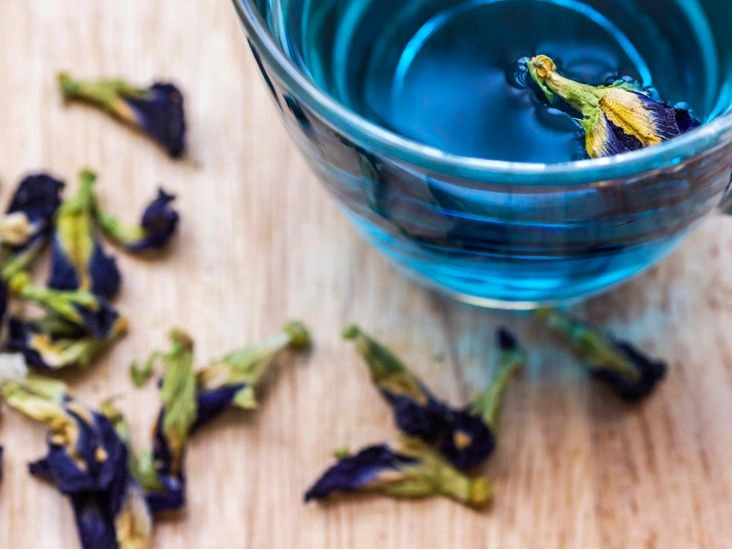Butterfly pea flower is loaded with antioxidants and has been connected to various health advantages, such as supporting weight management, helping regulate blood sugar, and promoting hair and skin health.
Native to Asia, butterfly pea flower (Clitoria ternatea) is often noted for its striking blue color, largely attributed to the plant’s high levels of antioxidant pigments called anthocyanins.
Because of this, butterfly pea flower is frequently used in beauty products and as a natural colouring agent for foods, beverages, and fabrics.
Beyond its use as a dye, butterfly pea flower may also possess medicinal qualities and has been associated with a range of possible health benefits.
Continue reading to discover more about the advantages and potential adverse effects of butterfly pea flower, plus suggestions for how to incorporate it into your routine.
Nutrients in butterfly pea flower
Butterfly pea flowers contain abundant anthocyanin pigments known as ternatins, which are responsible for the plant’s vivid coloration. Some in vitro studies suggest these compounds may help reduce inflammation, inhibit cancer cell proliferation, and influence obesity-related pathways.
The plant also provides several additional antioxidants, including:

- Kaempferol: This flavonoid has been widely researched for its anti-cancer potential. Laboratory studies indicate it may induce death in cancer cells.
- p-Coumaric acid: Some evidence suggests p-coumaric acid could help defend against oxidative damage, inflammation, and bacterial threats, while potentially supporting healthy aging.
- Delphinidin-3,5-glucoside: This antioxidant may stimulate immune activity and trigger cell death in colorectal cancer cells.
Supports skin and hair health
Butterfly pea flower is rich in antioxidants that may support both hair and skin wellness. The extract is used in a variety of products, from facial serums to hair mists and shampoos.
A 2021 study reported that topical application of butterfly pea extract increased skin hydration by 70% one hour after use.
A 2024 trial observed that a 20% Clitoria ternatea shampoo reduced dandruff severity with few adverse reactions, possibly due to the flower’s influence on sebum regulation.
Additionally, research indicates that butterfly pea extract may encourage hair growth and help prevent hair thinning.
Although these results are promising, more studies are required to clearly define how butterfly pea flower affects skin and hair health.
»Learn more:How to develop a natural skin care routineMay promote weight loss
Some evidence suggests that butterfly pea flower could support weight-reduction efforts.
For example, a 2019 in vitro study found that butterfly pea flower extract may impede fat cell formation by modulating pathways involved in cell development.
Other laboratory and animal studies have shown that ternatins present in butterfly pea flower can inhibit adipogenesis, which could help manage obesity and excess weight.
More human research is needed to determine how butterfly pea flower affects body weight when included in a typical diet.
»Learn more:How to lose weight naturallyStabilizes blood sugar levels
Research suggests butterfly pea flower may help lower the risk of diabetes and its associated symptoms.
In a small 2018 study, consuming a drink containing butterfly pea flower extract increased antioxidant activity and lowered blood glucose and insulin levels, despite the drink’s sugar content.
Similarly, some animal studies reported that diabetic rats given butterfly pea flower extract for 28 days showed notable reductions in blood sugar and increases in certain antioxidants and liver proteins.
The antioxidant action of butterfly pea flower may also help protect cells from damage and reduce diabetes-related complications.
However, further investigation is necessary to understand its effects on long-term glucose control.
»Learn more:How to lower blood sugar levels naturallyWhat are the side effects of butterfly pea flower?
Most nutrition experts consider butterfly pea flower safe when used in moderation.
Anecdotal accounts mention side effects such as nausea, stomach discomfort, and diarrhea after consuming butterfly pea flower, but there is little research confirming these claims.
If you have existing health issues, take medications, are pregnant, or are breastfeeding, consult your healthcare provider before using butterfly pea flower or other herbal remedies.
How to use butterfly pea flower
Butterfly pea flower appears in many cosmetic formulations, including hair mists, toners, shampoos, and face masks.
It’s also commonly brewed as an herbal infusion with an earthy flavor and vivid blue hue, often called “blue tea.”
To prepare butterfly pea flower tea, steep 1 teaspoon (4 grams) of dried flowers in 1 cup (240 mL) of hot water for 10 to 15 minutes, then strain out the flowers. Serve hot or chilled over ice.
For added taste, stir in a splash of lemon or lime juice, or a touch of honey. The acidity from citrus will often turn the beverage a rich purple because of the ternatins naturally present in the plant.
Frequently asked questions
Is it safe to drink butterfly pea flower tea every day?
Generally, yes — it’s considered safe for daily consumption.
Who shouldn’t drink butterfly tea?
There’s limited data on specific populations who should avoid butterfly pea tea.
As with other herbal drinks and supplements, check with a physician or pharmacist before using butterfly pea tea if you are pregnant, breastfeeding, taking medications, or have underlying health conditions.
The bottom line
Butterfly pea flower is a popular ingredient in many herbal teas, cocktails, and beauty products.
Rich in antioxidants, it’s associated with several potential health perks, including support for weight control, improved blood sugar regulation, and benefits for hair and skin.
It’s versatile and generally well tolerated, making it a potentially valuable addition to your diet or self-care routine.


















Leave a Reply
You must be logged in to post a comment.